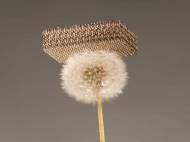Metal lighter than feather? New micro-lattice material is the World’s lightest material
 A team of researchers from UC Irvine, HRL Laboratories and the California Institute of Technology has developed the World’s lightest material which is about one hundred times lighter than Styrofoam. Developed for the Defense Advanced Research Projects Agency, the novel material could be used for battery electrodes and acoustic, vibration or shock energy absorption.
A team of researchers from UC Irvine, HRL Laboratories and the California Institute of Technology has developed the World’s lightest material which is about one hundred times lighter than Styrofoam. Developed for the Defense Advanced Research Projects Agency, the novel material could be used for battery electrodes and acoustic, vibration or shock energy absorption.
“Modern buildings, exemplified by the Eiffel Tower or the Golden Gate Bridge, are incredibly light and weight-efficient by virtue of their architecture. We are revolutionizing lightweight materials by bringing this concept to the nano and micro scales”, said William Carter, manager of the architected materials group at HRL.
This new material redefines the limits of lightweight materials because of its unique “micro-lattice” cellular architecture made of nickel-phosphorous tubes. Using an innovative fabrication process developed by HRL senior scientist Dr. Alan Jacobsen, the team was able to make a material that consists of 99.99 percent open volume by designing the 0.01 percent solid at the nanometer, micron and millimeter scales.
These materials are fabricated by starting with a template formed by self-propagating photopolymer waveguide prototyping, coating the template by electroless nickel plating, and subsequently etching away the template.
“The trick is to fabricate a lattice of interconnected hollow tubes with a wall thickness 1,000 times thinner than a human hair”, said lead author Dr. Tobias Schaedler of HRL.
The resulting metallic microlattices exhibit densities of 0.9 milligram per cubic centimeter. In addition to its ultra-low density, the material’s cellular architecture gives rise to unprecedented mechanical behavior for a metal, including complete recovery from compression exceeding 50 percent strain and extraordinarily high energy absorption. After compression, the micro lattice expands back to 98 percent of its original size, and little damage is noticeable.
“Materials actually get stronger as the dimensions are reduced to the nanoscale”, said Lorenzo Valdevit, UCI mechanical and aerospace engineer who was the UCI’s principal investigator on the project. “Combine this with the possibility of tailoring the architecture of the micro-lattice and you have a unique cellular material.”
For more information, read the paper puvlished in the Science journal: “Ultralight Metallic Microlattices“.









Very nice results. Any details on how it is produced?
I suppose it is recyclable contrary to Styrofoam.
It is a metal so it should be recyclable. Don’t think it would be much to recycle since it is only 0.01 of total volume.
author
I agree with William regarding recycling.
Here is the information I found at the Royal Society of Chemistry page regarding this subject:
To create the structure, a polymer template is first produced by placing a mask patterned with circular holes over a reservoir of a photosensitive thiol-ene monomer. UV light is shone on the mask and where the light meets the monomer it polymerises it. ‘As the light begins to polymerise the liquid monomer, the change in refractive index between the polymer and monomer begins to tunnel the light, just as in a fibre optic,’ says Schaedler. ‘This leads to the formation of a self-propagating photopolymer waveguide, or fibre, within the monomer reservoir. We form these waveguides in multiple directions and intersect them together to create an interconnected network. Then we clean out the uncured liquid monomer with a solvent, and the result is a micro-lattice structure, where the self-propagating waveguides are the individual structural lattice members.’
This lattice template is then dipped in a catalyst solution before being transferred to a nickel-phosphorus solution. The nickel-phosphorus alloy is then deposited catalytically on the surface of the polymer struts to a thickness of around 100nm. Once coated, the polymer is etched away with sodium hydroxide, leaving an identical lattice geometry of hollow nickel-phosphorus tubes.
Thanks for the info!
If its density is 0.9 mg/cm³, how come it doesn’t float in the air?
author
As it was said in the article, the metallic micro-lattices consist out of 99.99% open volume which means that the “material” itself is consisting out of 99.99% air and of 0.01% solids.
As I understand it, the material acts in the same way as a paper which floats on water and plunges down once it is soaked.
If the material was literally solid where it displaced air equal to its volume, it would float as expected.